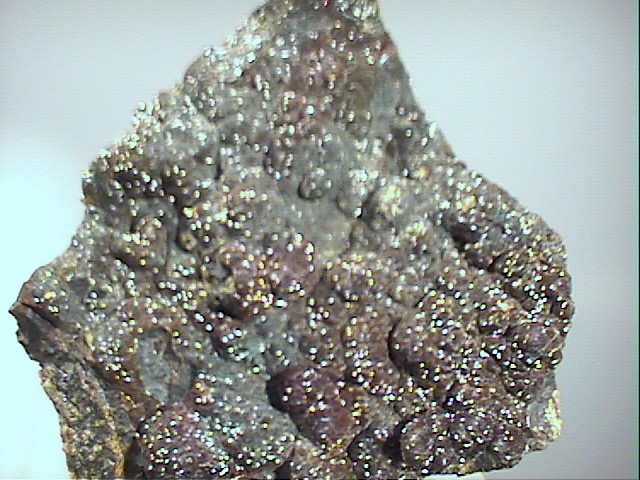
SIDERITE
Specimen sid-27
$ 30.00
Dims: 3.00x2.97x0.55" (7.63x7.54x1.39cm)
Wt: 4.66oz (132g)
Campbell Shaft (2400ft), Bisbee, Arizona, USA
This is a flat hand specimen of siderite. Both top and bottom are covered with a druze of siderite crystals, some areas of which are red, some gray. The gray crystals appear translucent, and these provide a great deal of sparkle and a pleasing optical effect on the surface. A loupe reveals that the top surface consists of thousands of small botryoidal formations, each of which displays consistent crystal faces with an iridescent reflection.
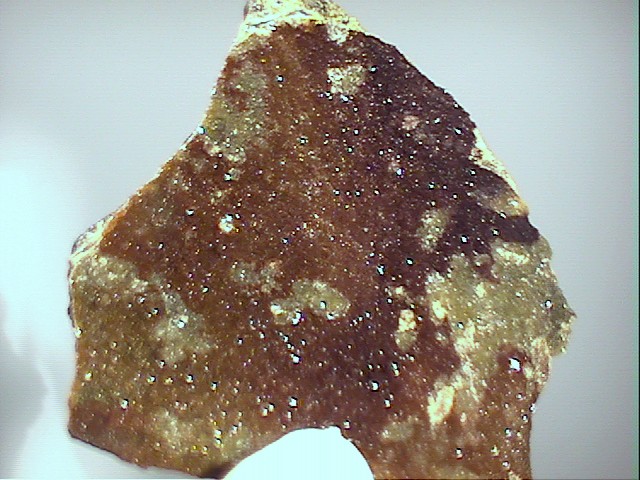
 Amethyst Galleries' Mineral Gallery MINERALS |
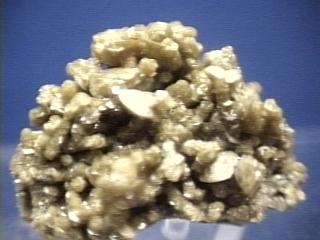
SIDERITE specimen sid-1
$ 30.00
$ 30.00
Dims: 2" x 1-1/2" x 1"
Wt: 2.3 oz
Tulcani Mine, Ancash, Peru
Out of the profuse diversity of minerals that Peru's Ancash Province yields to the collector comes this specimen of Siderite, a relatively unusual iron carbonate mineral. Its chemical relation to Calcite is obvious in this specimen, as can be seen through the luster and platy trigonal shape of the crystals, which are 1/4 inch at their largest. Stacking of the crystals on top of each other create a lustery "sparkle" that lends a lot of beauty to the dull, brownish-grayish-green color of the piece. The crystals are dimly translucent, and make up the specimen in its entirety- there is no host rock of any sort.

sid-1 ($ 30.00)
Tulcani Mine, Ancash, Peru
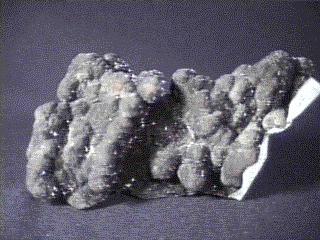
SIDERITE specimen sid-2
$ 70.00
$ 70.00
Dims: 6" x 3" x 1-1/2"
Wt: 2.3 oz
Junction Shaft, Bisbee, Cochise County, Arizona, U.S.A.
I love this next piece; it's one of our highest-quality Siderite specimens, and is one of the most aesthetically pleasing of any specimen that I have seen. It looks as if it occurred as a stalactite that was hanging down from a cave. It is a brownish-black color and has a botryoidal form. The surface is mostly covered with a fine druse that has a purplish tinge to it and an amazing velvety luster- I mean, it actually looks like there's velvet on the rock! Hot-glue this onto an acrylic base, and you will have a specimen that I think some museums couldn't beat!
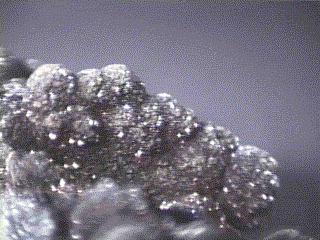

sid-2 ($ 70.00)
Junction Shaft, Bisbee, Cochise County, Arizona, U.S.A.
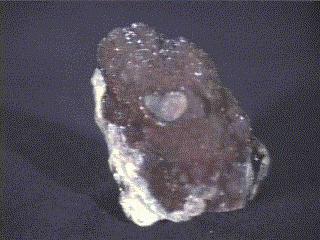
SIDERITE specimen sid-3
$ 25.00
$ 25.00
Dims: 3" x 2.50" x 2"
Wt: 10.8oz
Junction Shaft, Bisbee, Cochise County, Arizona, U.S.A.
This lovely specimen probably came off of a stalactite in the mine. The color is a blackish red-brown with a druse of tiny crystals covering the piece, giving it an exqisite velvety luster- it almost looks like the specimen is covered in velvet! There is a very slight damage to the druse on high points, but the velvet effect is pretty consistent, and makes for a choice collector's item.
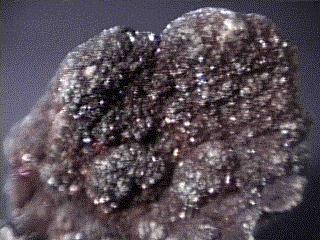

sid-3 ($ 25.00)
Junction Shaft, Bisbee, Cochise County, Arizona, U.S.A.
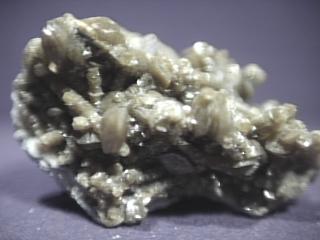
SIDERITE specimen sid-4
$ 45.00
$ 45.00
Dims: 2.6" x 2.0" x 1.7" (6.6 x 5.1 x 4.3 cm)
Wt: 2.70 oz. (76.5 g)
Tulcani Mine, Ancash, Peru
This specimen consists of many intergrown Siderite crystals. They occur in a tabular form with two very shallow trigonal pyramidal terminations that is often seen in calcite and is called "nailhead". These crystals have a dull brown color and are dimly translucent, but have a splendid adamantine luster. There is a small amount of visible damage to some of the crystals, but most are in excellent condition. I like this specimen best becase of its bright luster, which offsets the dullness of its color- I usually only see such combinations in specimen- or industrial-grade diamonds.

sid-4 ($ 45.00)
Tulcani Mine, Ancash, Peru
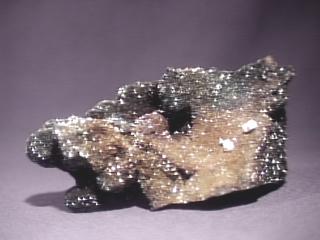
$ 250.00
Dims: 4.8" x 2.4" x 2.1" (12.2 x 6.1 x 5.3 cm)
Wt: 1 lb., 0.0 oz
Bisbee, Cochise County, Arizona, U.S.A.
Probably the most beautiful Siderite specimen that I have ever seen, this piece appears to have been part of a stalactite arrangement before it was harvested. It has a botryoidal form and shows little damage other than the spots where it was broken off its place of formation. The botryoidal nodules are formed by countless compact, radiating crystals whose terminations give the piece a wonderful luster that makes me think of crushed velvet. Its color ranges from gold to brown to almost green and blue in some spots, and the material is completely opaque. There are a few small whitish bits of material on the specimen that are likely made of a shale or mudstone, as they are very soft. Though it is not very sturdy, the specimen can stand on what I believe is its "top", and makes a beautiful and impressive display.
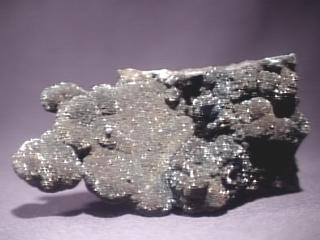

Bisbee, Cochise County, Arizona, U.S.A.
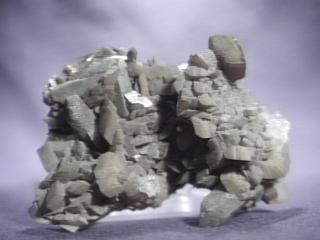
SIDERITE specimen sid-6
$ 275.00
$ 275.00
Dims: 3.5" x 2.4" x 1.7" (8.9 x 6.1 x 4.3 cm)
Wt: 6.28 oz
Morro Velho, Minas Gerais, Brazil
The Siderite crystals on this specimen occur in a trigonal, bladed form that is almost tabular in habit; they are actually flattened rhombohedrons. All have reasonably good definition, and damage is limited to only the most exposed crystals along the specimen's edges, including the largest crystal, whose dimensions measure 0.6 x 0.5 x 0.3" (1.5 x 1.3 x 0.8 cm). All of them have a dull brown coloration with a hint of green, and a dull, almost satiny luster. The green coloration and dull luster are due to a generous coating of tiny chlorite platelets that are dusted on the crystals. This also makes them only dimly translucent. There are a few other minerals present on the specimen that are worthy of mention, including several quartz crystals. These crystals have the standard hexagonal prismatic form that is common for them, though their edges are more rounded than usual, likely due to the chlorite that also heavily coats them. They have taken on the dull, deep green of the chlorite, and have a pearly, almost satiny luster of their own. They are also dimly translucent, though it is obvious from close examination that the chlorite does not pervade their interiors. There are also two patches of astonishingly clear, tabular apatite crystals! They are in the shape of flat, hexagonal tablets and are so heavily intergrown that their actual form is rather difficult to determine. They have well-defined edges and faces that reflect a bright, vitreous luster, and the crystals are transparent and remarkably clear, showing a few cloudy inclusions. Their color appears to be a very pale pink, but may actually be closer to colorless. If I didn't have the documentation, I would think that these platelets are actually beryls, as most of the apatites that I see don't have such definition. It is a very interesting and entertaining piece to examine.
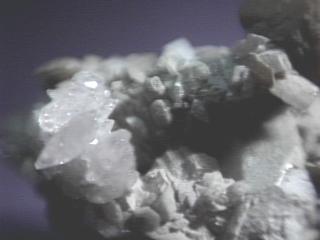

sid-6 ($275.00)
Morro Velho, Minas Gerais, Brazil
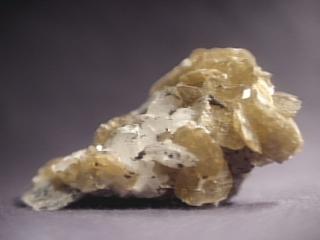
SIDERITE specimen sid-7
$ 55.00
$ 55.00
Dims: 3.9" x 2.0" x 1.5" (9.9 x 5.1 x 3.8 cm)
Wt: 4.52 oz. (128.4 g)
Morro Velho, Minas Gerais, Brazil
At least 20 golden blades of Siderite rest on the mica schist host rock of this specimen. They are in moderately good condition, but some of them show substantial damage. They are quite large, however, achieving dimensions of 1.0 x 0.5 x 0.2" (2.5 x 1.3 x 0.5 cm)(see the close-up image), and have good form, with sharp edges and finely striated faces that have a bright, pearly-to-vitreous luster. Their color is a moderate golden-brown and they are transparent and clear in a few spots, between their substantial internal cleavage lining. There are a few dolomite crystals among the Siderites; they look quite similar in form, but are colorless. Small pyrrhotite crystals grow off of both the Siderites and dolomites. They also occur in the form of very thin blades. I like the fact that the Siderites and dolomites grew together in the same form.
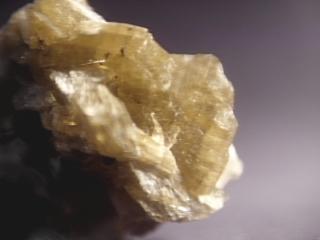

sid-7 ($ 55.00)
Morro Velho, Minas Gerais, Brazil
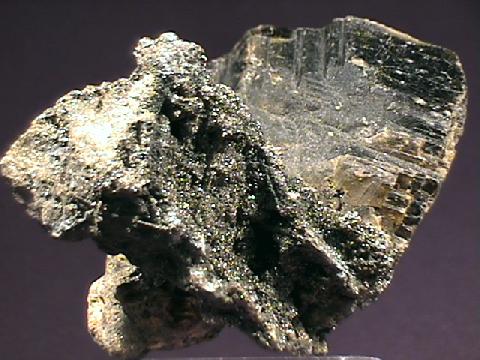
SIDERITE specimen sid-8
$ 60.00
$ 60.00
Dims: 3.4" x 3.1" x 2.7" (8.6 x 7.9 x 6.9 cm)
Wt: 13.1 oz. (371 g)
level 240, Huanuni Mine, Oruro Department, Bolivia
There are 4 trigonal tabular Siderite crystals on this specimen, all of which appear to be in very good condition. The largest of these crystals has dimensions of 2.5 x 2.4 x 1.3" (6.4 x 6.1 x 3.3 cm)- it is the largest Siderite crystal that I have seen. The other crystals do not exceed 1" (2.5 cm) in any dimension. All have a rather rough appearance but only the largest crystal shows any obvious human-induced damage. Their form is good, with well-defined edges and striated but clean faces that possess a pearly luster. The crystals have a brown color that is much darker than most that I have seen in Siderite crystals; this color is so deep that the larger crystal shows only a dim translucence around its edges in strong sunlight! The smaller crystals show good translucence and even a few small patches of transarence. These crystals are all attached to a base rock that is made up mostly of pyrite. This pyrite takes the form of very tiny, intergrown octahedrons and shows the standard metallic luster, though its golden color is a bit darker than usual. However, the pyrite crystals seem to permeate a matrix of either calcite or more Siderite.
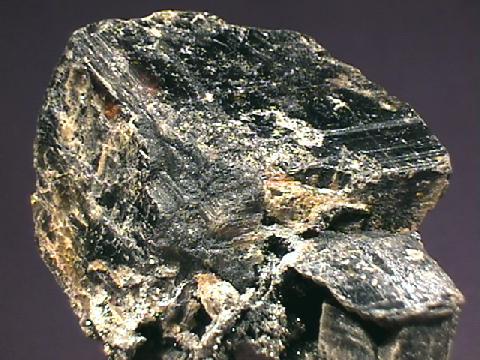

sid-8 ($ 60.00)
level 240, Huanuni Mine, Oruro Department, Bolivia
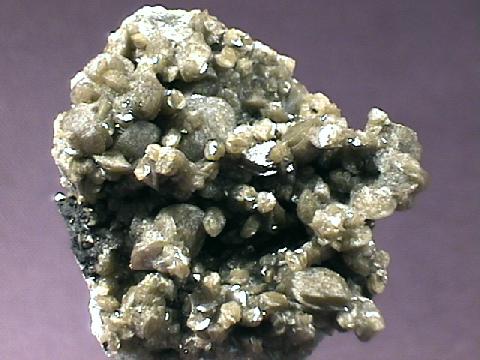
SIDERITE specimen sid-9
$ 32.00
$ 32.00
Dims: 2.2 x 2.1 x 1.4" (5.6 x 5.3 x 3.6 cm)
Wt: 3.52 oz. (100.0 g)
Hulcani Mine, Ancash Department, Peru
Scores of intergrown Siderite platelets make up most of this large thumbnail specimen. These round, flat crystals are in excellent condition given their high exposure, showing only a small amount of human-induced damage. They range in diameter from less than 0.1" (3 mm) to nearly 0.4" (1 cm) and show a somewhat rounded but still well-defined trigonal tabular form that could be called a "nail-head" form. All have a generally dull brown coloration and a bright pearly luster that appears to be nearly adamantine in some respects. The smaller crystals are readily translucent under normal light, and larger crystals are only dimly so. Damage to the edge of the specimen reveals some interesting details- it would appear that the Siderites actually cover either crystalline or stalactitic formations of some other mineral that is most likely iron-based. I am thinking that the material might be either chalcopyrite or possibly even bornite. These minerals rest on a dull, pale brown host rock that has an almost chalky appearance.
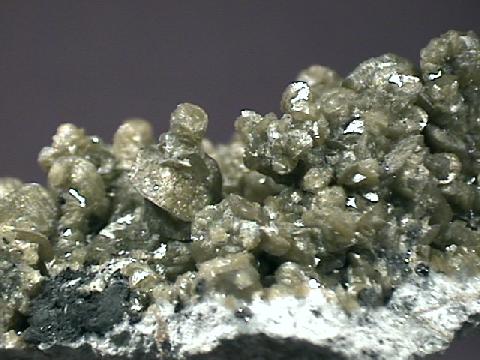

sid-9 ($ 32.00)
Hulcani Mine, Ancash Department, Peru
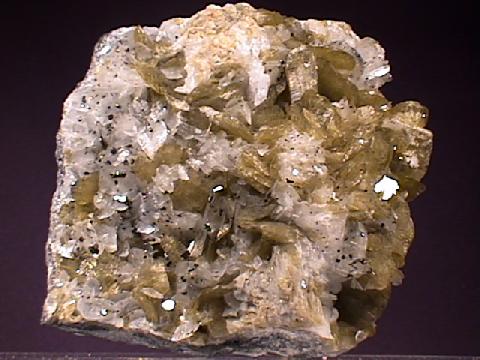
SIDERITE specimen sid-10
$ 75.00
$ 75.00
Dims: 4.3 x 4.2 x 2.3" (10.9 x 10.7 x 5.8 cm)
Wt: 2 lbs., 7.1 oz. (1.108 kg)
Morro Velho, Minas Gerais, Brazil
This large hand specimen consists of a cluster of both Siderite and either ankerite or calcite blades (most likely ankerite). Though many of the Siderites are damaged, they are of larger size than the ankerites, having diameters of up to 0.9" (2.3 cm). Their trigonal tabular form is good; though "termination" edges are very rounded and difficult to define, their outer edges are very sharp. All have faces that are heavily patterned and graded, slightly dimming their high pearly luster. Though the ankerite crystals are very similar in form and luster, the two are easy to tell apart- the larger Siderites have a moderately pale brown coloration, whereas the ankerites are milky-white. Both show dim transparence. The ankerites are lightly dusted with small hexagonal platelets of a sulfide mineral, which I believe is marcasite or pyrrhotite. The Siderite/ankerite crust covers most of the surface of the gray calcareous host rock.
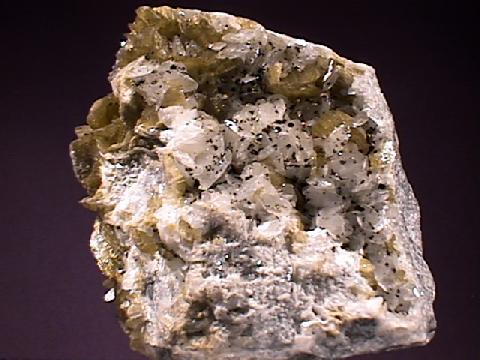

sid-10 ($ 75.00)
Morro Velho, Minas Gerais, Brazil

SIDERITE specimen sid-11
$ 35.00
$ 35.00
Dims: 1.6 x 1.1 x 0.8" (4.1 x 2.8 x 2.0 cm)
Wt: 19.6 g
Mount Saint Hilaire, Quebec, Canada
At least 10 small, partly intergrown Siderite crystals make up the bulk of this thumbnail specimen. They range in size from 0.1" (3 mm) along each axis to 0.9 x 0.7 x 0.5" (2.3 x 1.8 x 1.3 cm) and are in excellent condition, though one or two show obvious cleavage. All have excellent rhombohedral form, with sharp edges and striated but basically clean faces that possess the standard pearly luster. Their color is a moderately dark brown, and all are moderately to dimly translucent- their translucence decreases as their size increases. Accompanying the Siderites are formations of a white mineral that I cannot quite identify. It is not a carbonate, as it shows no effervescence in strong hydrochloric acid. I think that it might actually be albite or microcline, but its form is not condusive to those species, ranging from tiny blades to radiating, almost needle-like spikes. There is no host or base rock present.

sid-11 ($ 35.00)
Mount Saint Hilaire, Quebec, Canada
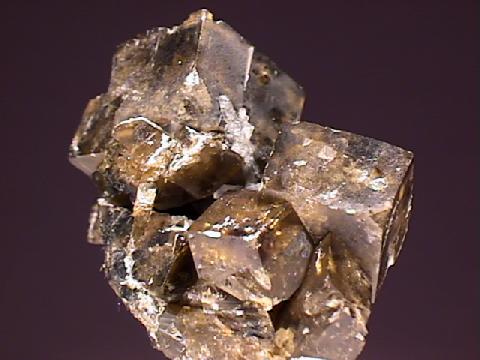
SIDERITE specimen sid-12
$ 32.00
$ 32.00
Dims: 1.1 x 1.1 x 0.7" (2.8 x 2.8 x 1.8 cm)
Wt: 21.6 g w/ base
Mount Saint Hilaire, Quebec, Canada
At least 20 Siderite crystals are clustered together to make up this thumbnail specimen. They range in size from 1 x 1 x 1 mm up to 0.6 x 0.4 x 0.4" (1.5 x 1.0 x 1.0 cm). All are in surprisingly good condition- there are several areas of obvious breakage, but close examination will show that partial healing had begun on all of them before the piece was mined. Their rhombohedral form is very good, showing well-defined edges and generally clean faces that possess the standard pearly luster. All have a moderately dark brown coloration and are dimly translucent under normal light, though some of the smaller crystals are nearly transparent. A tiny, flat spray of quartz crystals rests upon one of the crystals, but this is the only other material present on the piece, which is hot-glued onto a flat, square acrylic base.

sid-12 ($ 32.00)
Mount Saint Hilaire, Quebec, Canada
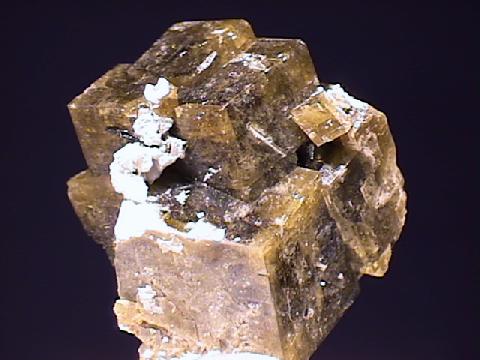
SIDERITE specimen sid-13
$ 40.00
$ 40.00
Dims: 1.2 x 1.1 x 0.8" (3.0 x 2.8 x 2.0 cm)
Wt: 22.2 g w/ base
Mount Saint Hilaire, Quebec, Canada
About 7 or 8 discernable Siderite crystals make up the bulk of this thumbnail specimen. They range in size from about 0.1 x 0.1 x 0.1" (3 x 3 x 3 mm) to 0.6 x 0.5 x 0.5" (1.5 x 1.3 x 1.3 cm) and are generally in good condition, though a few show visible damage, and one is cleaved and incomplete. Their rhombohedral form is excellent- all have well-defined edges and clean faces that possess the standard pearly luster. They have the obligatory brown coloration of Siderite from this locality, and are moderately to dimly translucent under halogen light. A small amount of either albite or malformed analcime rests on two spots on the cluster- a small black aegirine spike extends from one of them. There is no host rock present, and the piece is hot-glued onto an acrylic base.

sid-13 ($ 40.00)
Mount Saint Hilaire, Quebec, Canada
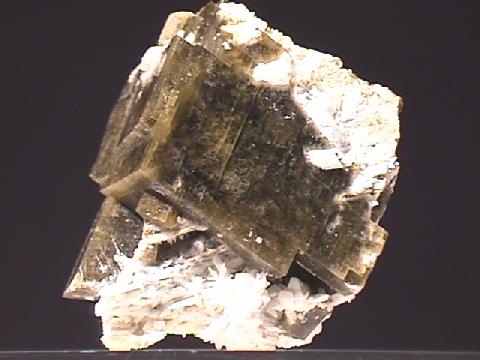
SIDERITE specimen sid-14
$ 80.00
$ 80.00
Dims: 1.6 x 1.2 x 0.9" (4.1 x 3.0 x 2.3 cm)
Wt: 2.02 oz. (57.5 g)
Mount Saint Hilaire, Quebec, Canada
This specimen consists primarily of 7 or 8 intergrown Siderite crystals. These crystals range in size from less than 0.1" (3 mm) along each axis up to 1.3 x 1.1 x 0.9" (3.3 x 2.8 x 2.3 cm) and are generally in excellent condition- only one or two of the smaller crystals are visibly damaged. All have excellent trigonal-based rhombohedral form, with well-defined edges and clean faces that possess a pearly luster. They have a moderately dark brown coloration with a hint of yellow, and all but the smallest crystals are essentially opaque under normal light. Though there is no actual host rock present, several small clusters of 2 different white minerals are present; there are many tiny, well-formed albites that are partly intergrown with what look like sprays of equally small and well-formed natrolite blades. Many of these small crystals are damaged or crushed, but a few clusters are in good condition.

sid-14 ($ 80.00)
Mount Saint Hilaire, Quebec, Canada
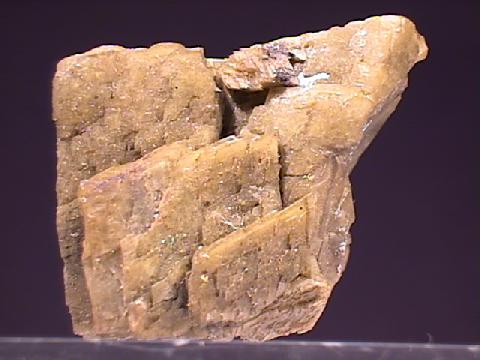
SIDERITE specimen sid-15
$ 80.00
$ 80.00
Dims: 1.2 x 1.0 x 0.6" (3.0 x 2.5 x 1.5 cm)
Wt: 27.5 g
Neudorf, Germany
A cluster of 2 or 3 intergrown Siderite crystals constitute this German specimen. Though a large portion of the Siderite is obviously cleaved, the rest of it is intact and in very good condition, showing almost no damage. The crystals have good rhombohedral form with slightly curved edges and rounded faces that possess a pearly luster. They have the standard brown coloration and are only dimly translucent around their edges under bright light. There is no host rock present on this piece. It is one of the few specimens of any mineral that we have from Germany.

sid-15 ($ 80.00)
Neudorf, Germany
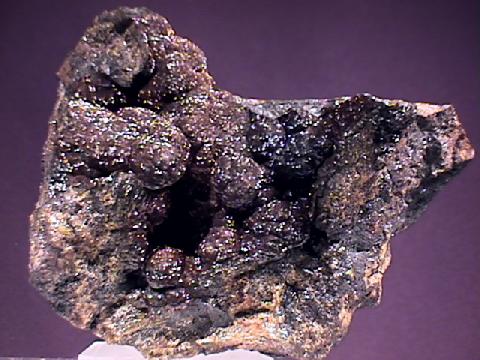
SIDERITE specimen sid-16
$ 80.00
$ 80.00
Dims: 4.8 x 4.0 x 2.1" (12.2 x 10.2 x 5.3 cm)
Wt: 1 lb., 10.4 oz. (749 g)
Bisbee, Arizona, U.S.A.
This hand specimen appears to consist mostly of Siderite. The Siderite occurs in the form of a botryoidal crust made up of round formations. These formations achieve diameters of up to 0.8" (2.0 cm). A few of the most exposed surfaces of the crust are visibly scuffed or damaged, but much of it is still in excellent condition. No actual trigonal-based form is evident, but the botryoidal habit suggests its crystalline nature. The crust ranges in color from a dull red-brown to a deep blue violet, and has a beautiful silky luster. The underlying material has a basic brown coloration, and the host rock is brown with black stains and contains a visible pocket of white calcite.
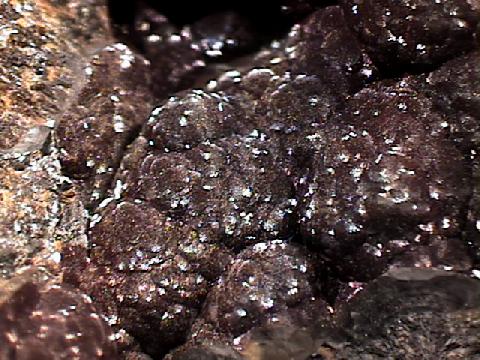

sid-16 ($ 80.00)
Bisbee, Arizona, U.S.A.
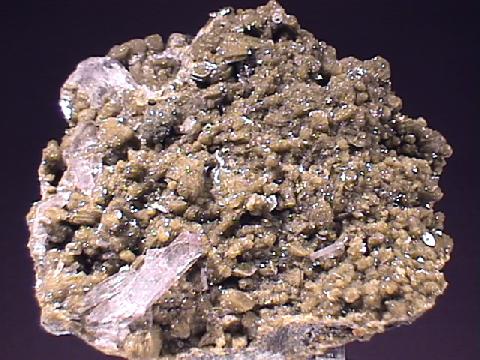
SIDERITE specimen sid-17
$ 75.00
$ 75.00
Dims: 5.2 x 4.5 x 2.4" (13.2 x 11.4 x 6.1 cm)
Wt: 2 lbs, 2.2 oz. (969 g)
Hulcani Mine, Ancash Department, Peru
The Siderite on this large hand specimen consists of a crust that covers nearly half of the base rock. This crust is made up of countless trigonal Siderite blades that do not exceed 0.4" (1.0 cm) in diameter (most of them do not exceed 0.2" or 5 mm in diameter). Though areas of substantial damage are present and visible, the crust is generally in good condition. All of the crystals have a somewhat rounded shape, and most are warped due to intense intergrowth, but a few show well-defined edges and clean faces. Their brown color and pearly luster are standard for their species, and they are translucent at best. Accompanying the Siderites are several orthorhombic prismatic crystals that look very much like celestites. I am almost sure that they ARE celestites, though I may well be wrong. Most of these crystals are broken, but a few are undamaged and in excellent condition. Their form is also excellent, and all are transparent and very clear. They appear to be colorless, but from some angles a few of them seem to have a very faint, almost violet tinge. The chalky base rock appears to be coated in a few places with druses of tiny, white quartz crystals, and is suffused with either bornite or chalcopyrite.
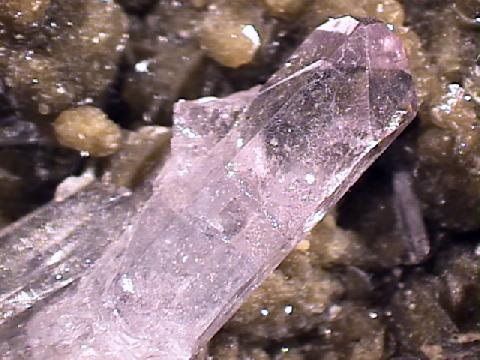

sid-17 ($ 75.00)
Hulcani Mine, Ancash Department, Peru
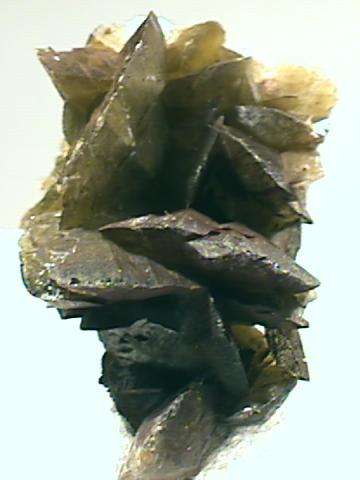
SIDERITE specimen sid-18
$ 45.00
$ 45.00
Dims: 1.3 x 0.8 x 0.6" (3.3 x 2.0 x 1.5 cm)
Wt: 21.5 g w/ specimen box
Kalgoorlie, Australia
At least 15 distinct Siderite crystals make up the crust that comprises this specimen. These crystals are generally in very good condition, as only a few at the edges of the crust are broken or damaged. Those that are intact reach diameters of nearly 0.7" (1.8 cm) and possess a rounded but good trigonal tabular form. Their edges are uneven but sharp, and their faces are relatively clean, possessing an almost silky, pearly luster. All have the standard brown coloration, though a few appear to be slightly rust-stained or coated with a thin layer of goethite. Those that are not coated are translucent to dimly transparent, whereas the coated crystals are essentially opaque. There is no associated base or host rock present, and the piece is affixed to a plastic specimen box with a hot-glue.

sid-18 ($ 45.00)
Kalgoorlie, Australia
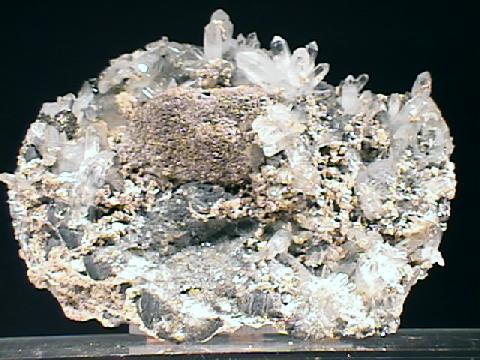
SIDERITE specimen sid-19
$ 27.00
$ 27.00
Dims: 4.4 x 3.2 x 1.8" (11.2 x 8.1 x 4.6 cm)
Wt: 1 lb., 2.4 oz. (523 g)
Pachapaqui Mine, Ancash Department, Peru
This specimen consists of dozens of Siderite crystals resting on a quartz/galena base. The largest of these crystals is quite obvious, as it is far larger than all of the other crystals on the piece. It has dimensions of 1.4 x 0.9 x 0.5" (3.6 x 2.3 x 1.3 cm) and is in excellent condition, showing no damage. Its trigonal tabular form is rather rounded, but I believe that this is due to a crust of smaller Siderites that coats it. The smaller crystals tend to be massed in small clusters and have a rhombohedral shape. All are pale brown in color, waxy in luster and opaque. They are accompanied by several beautiful sprays of small quartz crystals, and all rest on a base made of more Siderite and quartz, a small amount of chalcopyrite, and a large amount of rounded but crystalline galena.
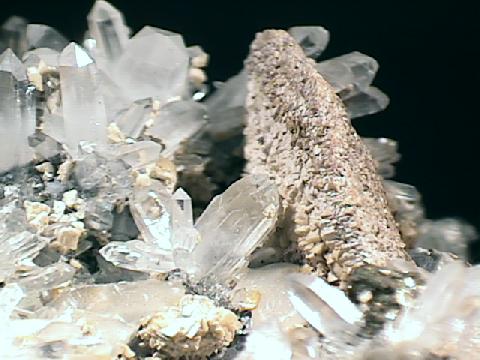

sid-19 ($ 27.00)
Pachapaqui Mine, Ancash Department, Peru
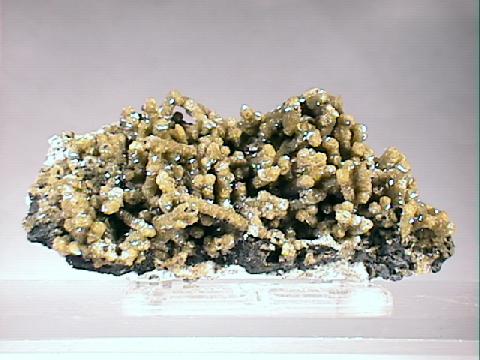
SIDERITE specimen sid-20
$ 33.00
$ 33.00
Dims: 3.3 x 1.5 x 1.1" (8.4 x 3.8 x 2.8 cm)
Wt: 3.06 oz. (86.7 g)
Tulcani Mine, Ancash Department, Peru
This hand specimen consists of a cluster of Siderite stalactites that extends from a goethite or manganese oxide base. These stalactites are generally in good condition- a few are noticeably damaged- the siderite on each is crystalline, but heavily intergrown. There is at least one complete trigonal tabular crystal present, though its form is a bit warped due to intergrowth. All have a rather dull brown color and a pearly luster, and are translucent at best. The Siderite actually coats very fine stalactites of the base rock.

sid-20 ($ 33.00)
Tulcani Mine, Ancash Department, Peru
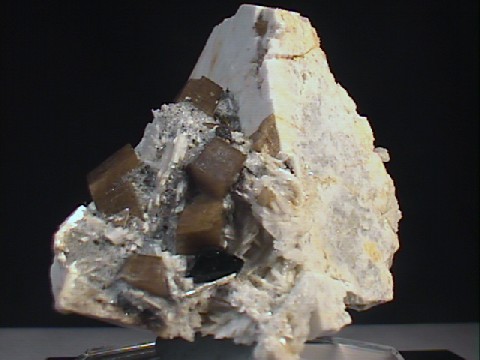
SIDERITE specimen sid-22
$ 38.00
$ 38.00
Dims: 2.1 x 2.1 x 1.4" (5.4 x 5.3 x 3.7 cm)
Wt: 2.7 oz. (76 g)
Mount Saint-Hilaire, Quebec, Canada
Less than 10 Siderite crystals rest on the microcline base of this large hand specimen. These crystals are in excellent condition, showing no damage, and reach dimensions of 0.4 x 0.3 x 0.3" (9 x 8 x 7 mm). All have excellent trigonal rhombohedral form and show the classic brown color and a pearly luster. They are accompanied by many small natrolite blades and a few black blades that I cannot identify; they could be sphenes or aegirines. The microcline base shows some crystal form, but it is rather warped.

sid-22 ($ 38.00)
Mount Saint-Hilaire, Quebec, Canada
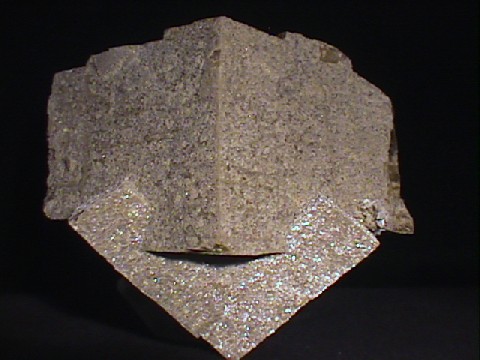
SIDERITE specimen sid-21
$ 57.00
$ 57.00
Dims: 3.9 x 3.4 x 2.9" (9.9 x 8.7 x 7.3 cm)
Wt: 1 lb., 5.3 oz. (604 g)
Mount Saint-Hilaire, Quebec, Canada
Two very large, intergrown Siderite crystals make up this cabinet specimen. These crystals are in moderately good condition; the larger of the two shows extensive damage and is incomplete, even though most of the damage is not recent. The smaller crystal is partly intergrown with the larger, but is intact and in very good condition, showing very little damage. The larger crystal has dimensions of 3.8 x 2.9 x 2.6" (9.7 x 7.3 x 6.5 cm) and the smaller has dimensions of 2.8 x 1.6 x 1.2" (7.2 x 4.0 x 3.0 cm). Both show excellent trigonal rhombohedral form and have a pale brown color and dull, silky luster on their undamaged surfaces. Damaged surfaces have a darker brown color and a pearly luster, and older damage has a luster that is faintly duller and a subtle, colorful iridescence. A small cluster of tiny pyrites is embedded in the larger crystal, and a small cluster of radiating natrolite blades rests almost on top of the piece. There is no host rock present.
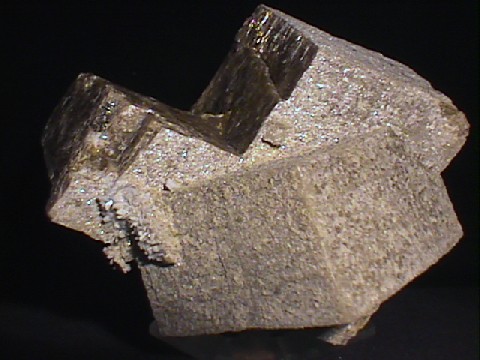

sid-21 ($ 57.00)
Mount Saint-Hilaire, Quebec, Canada
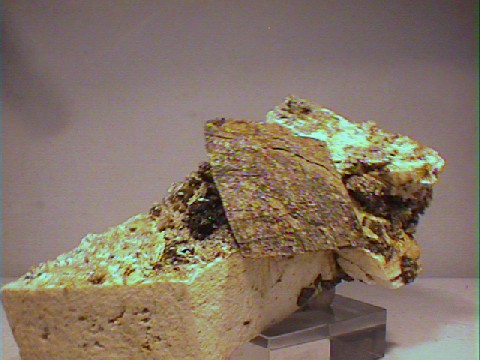
SIDERITE specimen sid-23
$ 42.00
$ 42.00
Dims: 4.0 x 2.0 x 1.9" (10.1 x 5.0 x 4.8 cm)
Wt: 7.3 oz. (207 g)
Mount Saint Hilaire, Quebec, Canada
Several Siderite rhombohedra rest on the microcline base of this cabinet piece. These crystals are generally in good condition, though one or two are obviously broken. All but one measure under 0.3" (8 mm) in diameter, but the largest one has dimensions of 1.4 x 1.0 x 1.0" (3.6 x 2.6 x 2.5 cm). All have a dull, dark brown coloration and a dull pearly luster and are dimly translucent at best. Their trigonal rhombohedral form is generally somewhat disseminated and warped. The base on which it rests is made up of several intersecting microcline crystals that show excellent triclinic form and moderate to severe damage.

sid-23 ($ 42.00)
Mount Saint Hilaire, Quebec, Canada
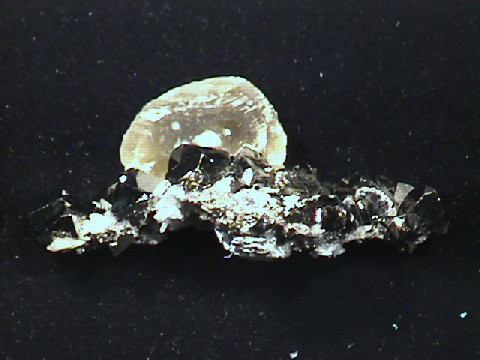
SIDERITE specimen sid-24
$ 30.00
$ 30.00
Dims: 1.54x0.59x0.59" (3.9x1.5x1.5cm)
Wt: 0.29oz. (8.2g)
Bolivia
This pretty thumbnail specimen is a cluster of brassy pyrite crystals with a single flat and round siderite crystal perched neatly. The siderite has a sharp edge, rather like a round axe blade. It is light brown in color, and is translucent with a dull luster. The specimen also has a scattering of tiny quartz crystals.

sid-24 ($ 30.00)
Bolivia
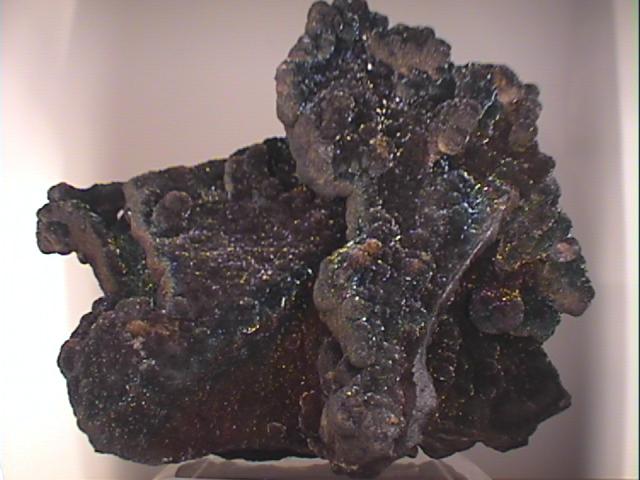
$ 400.00
Dims: 7.63x6.48x2.98" (19.37x16.46x7.56cm)
Wt: 78.84oz (2235g)
Junction Shaft, Bisbee, Cochise County, Arizona, USA
An extremely beautiful siderite specimen, this cabinet piece consists of radial growths of small siderite crystals over a base that must have included thin sheets, much like barite has been known to form. I have seen some corals with a shape like this, flat branches with random blobs. The siderite layer is 3 to 6mm thick on both sides of those sheets, resulting in a mamilary pattern of brightly sparkling siderite crystals. Best, they have a bright and classic irridescence in colors of blue, purple, and red, with some hightlights of green and yellow. The bottom of the specimen has crystals that appear dull, and brown to gray in appearance. Some of the siderite crystals are several millimeters across, allowing inspection of their form, which is stacked sheets of rhombic flat crystals. In a few areas, the crystals are pale and translucent, but nearly all of them appear dark and opaque, likely due to a thin coating of the same weathering product that provides the collorful irridescence.


Junction Shaft, Bisbee, Cochise County, Arizona, USA

SIDERITE specimen sid-27
$ 30.00
$ 30.00
Dims: 3.00x2.97x0.55" (7.63x7.54x1.39cm)
Wt: 4.66oz (132g)
Campbell Shaft (2400ft), Bisbee, Arizona, USA
This is a flat hand specimen of siderite. Both top and bottom are covered with a druze of siderite crystals, some areas of which are red, some gray. The gray crystals appear translucent, and these provide a great deal of sparkle and a pleasing optical effect on the surface. A loupe reveals that the top surface consists of thousands of small botryoidal formations, each of which displays consistent crystal faces with an iridescent reflection.


sid-27 ($ 30.00)
Campbell Shaft (2400ft), Bisbee, Arizona, USA
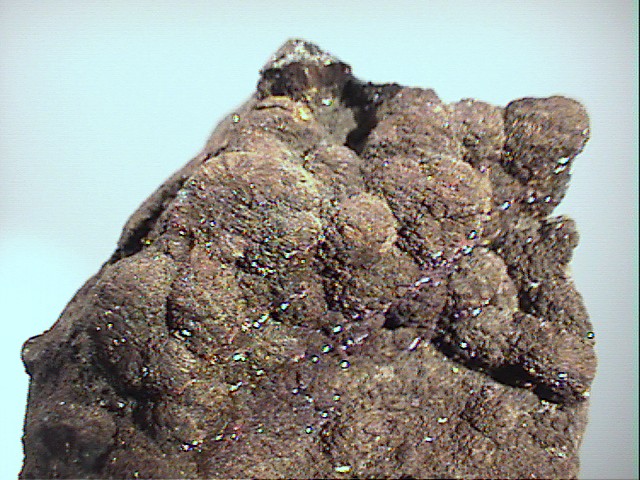
SIDERITE specimen sid-26
$ 36.00
$ 36.00
Dims: 2.93x2.40x1.70" (7.43x6.11x4.33cm)
Wt: 9.10oz (258g)
Campbell Shaft (2400ft), Bisbee, Arizona, USA
This hand specimen is covered with a layer of siderite crystals, plus numerous botryoidal clusters. They are opaque and a red-brown color, with individual crystals too small to examine. They have an irridescent surface that adds sparkle to the specimen in hues of red.
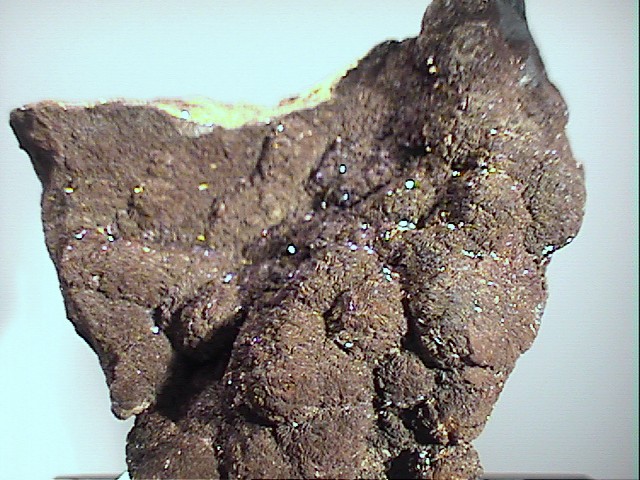

sid-26 ($ 36.00)
Campbell Shaft (2400ft), Bisbee, Arizona, USA